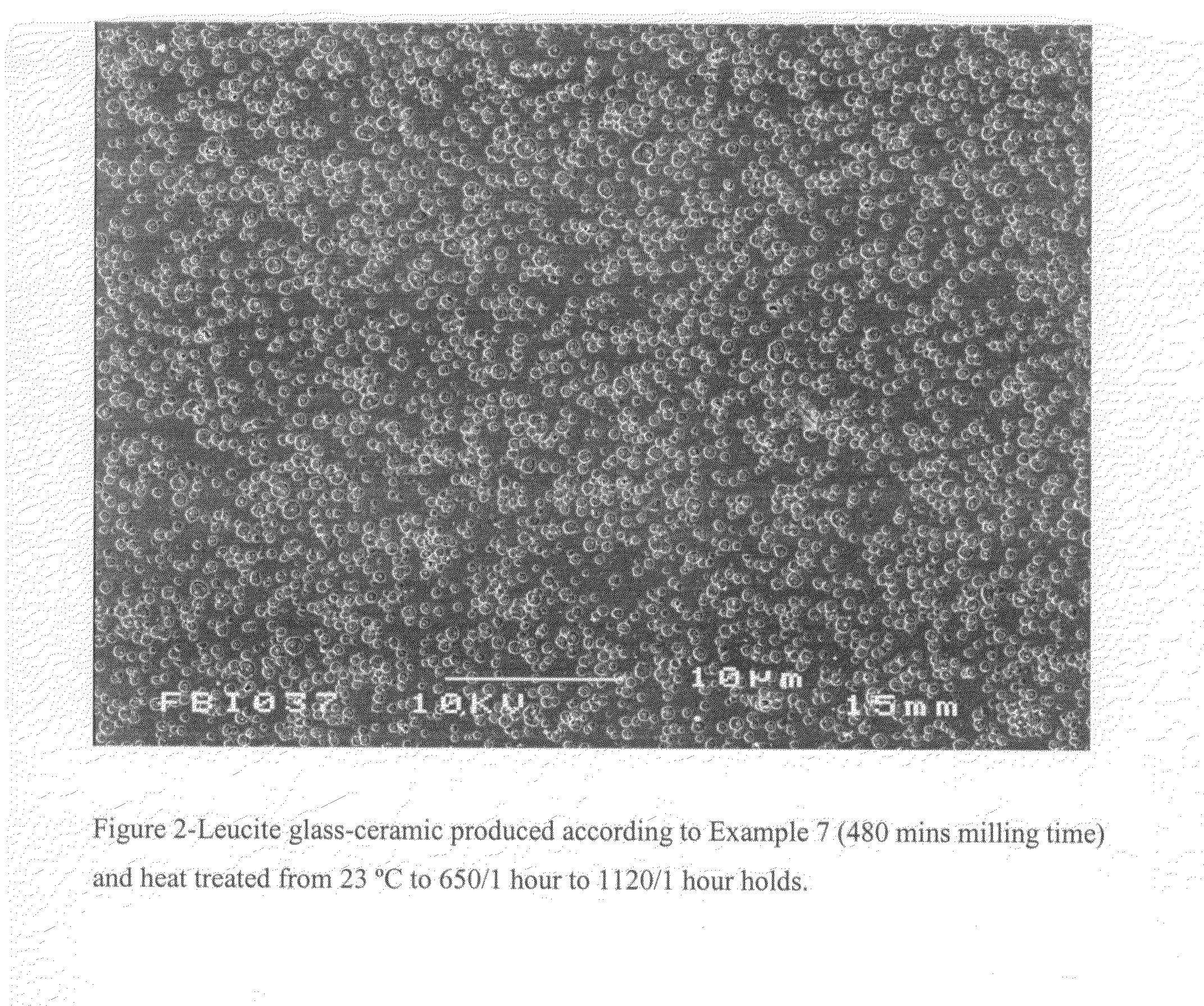Control of ceramic microstructure
a microstructure and ceramic technology, applied in the field of low wear, dental glassceramic, can solve the problems of inability to control simultaneous opacity and strength, limited opacity and strength, and only temporary cemented in place of veins, and achieve uniform particle size and uniform size
- Summary
- Abstract
- Description
- Claims
- Application Information
AI Technical Summary
Benefits of technology
Problems solved by technology
Method used
Image
Examples
example 1
Preparation of the Leucite-Free Glass
[0039]All raw ingredients were obtained and used as powders (−325 mesh, US Series screen) A batch (˜27 Kg) of frit was prepared by blending 22.226 Kg powdered potassium feldspar (composition of SiO2, 66.3%, Al2O3, 18.50%, Na2O, 3.04%, K2O, 10.75%, CaO, 0.81% and MgO, 0.05%) with 3.922 Kg of a first glass powder (SiO2, 55.4%, Al2O3, 7.19%, Na2O, 6.68%, K2O, 20.2%, MgO, 1.92%, CaO, 8.32%, SrO, 0.05%, BaO, 0.22% and TiO2, 0.02%), 0.534 Kg of a second glass powder (SiO2, 46.6%, Al2O3, 0.615%, B2O3, 6.09%, MgO, 0.052%, CaO, 4.83%, SrO, 2.57%, BaO, 10.5%, Na2O, 17.0%, K2O, 0.22%, TiO2, 9.46%, F, 3.65%) and 0.334 Kg of powdered lithium carbonate. After the raw materials were thoroughly blended the powder mixture was packed into square cordierite saggers (25 cm width and length and 8.5 cm deep)) that had previously been coated with a 3 mm layer of tabular alumina (50 micron average particle size). The saggers were then stacked into an electric furnace, f...
examples 2 , 3 , 4 , 5 and 6
EXAMPLES 2, 3, 4, 5 And 6
Preparation of Frit Specimens Ground to Different Particle Sizes
[0040]The frit of example 1 was used as the feedstock for the preparation of more finely ground glass powder. Grinding was carried out in a Union Process Attritor Mill (Union Process, 1925 Akron-Peninsula Road, Akron, Ohio 44313), Model 1-S. The mill was equipped with a 1 gallon water-jacketed grinding chamber, was driven by a 2 horsepower electric motor equipped with a variable speed drive and the grinding chamber was charged with 12.21 Kg of 5 mm spherical yttria stabilized zirconia grinding media. The particle size distributions of all ground ceramic powders were characterized with a Mastersizer / E particle analyzer (Malvern Instruments, UK).
example 2
[0041]The grinding chamber of the 1-S attritor was charged with 2.000 Kg of the glass frit of Example 1 and 2550 mL of distilled water. The mill agitator was run at 600 rpm for 30 minutes and the frit slurry was discharged to four Pyrex dishes and dried at 122 oC for 48 hours to yield 1.902 Kg of glass powder with a mean particle size of 4.73 microns.
PUM
| Property | Measurement | Unit |
|---|---|---|
| particle size | aaaaa | aaaaa |
| particle size | aaaaa | aaaaa |
| particle size | aaaaa | aaaaa |
Abstract
Description
Claims
Application Information
 Login to View More
Login to View More - R&D
- Intellectual Property
- Life Sciences
- Materials
- Tech Scout
- Unparalleled Data Quality
- Higher Quality Content
- 60% Fewer Hallucinations
Browse by: Latest US Patents, China's latest patents, Technical Efficacy Thesaurus, Application Domain, Technology Topic, Popular Technical Reports.
© 2025 PatSnap. All rights reserved.Legal|Privacy policy|Modern Slavery Act Transparency Statement|Sitemap|About US| Contact US: help@patsnap.com


